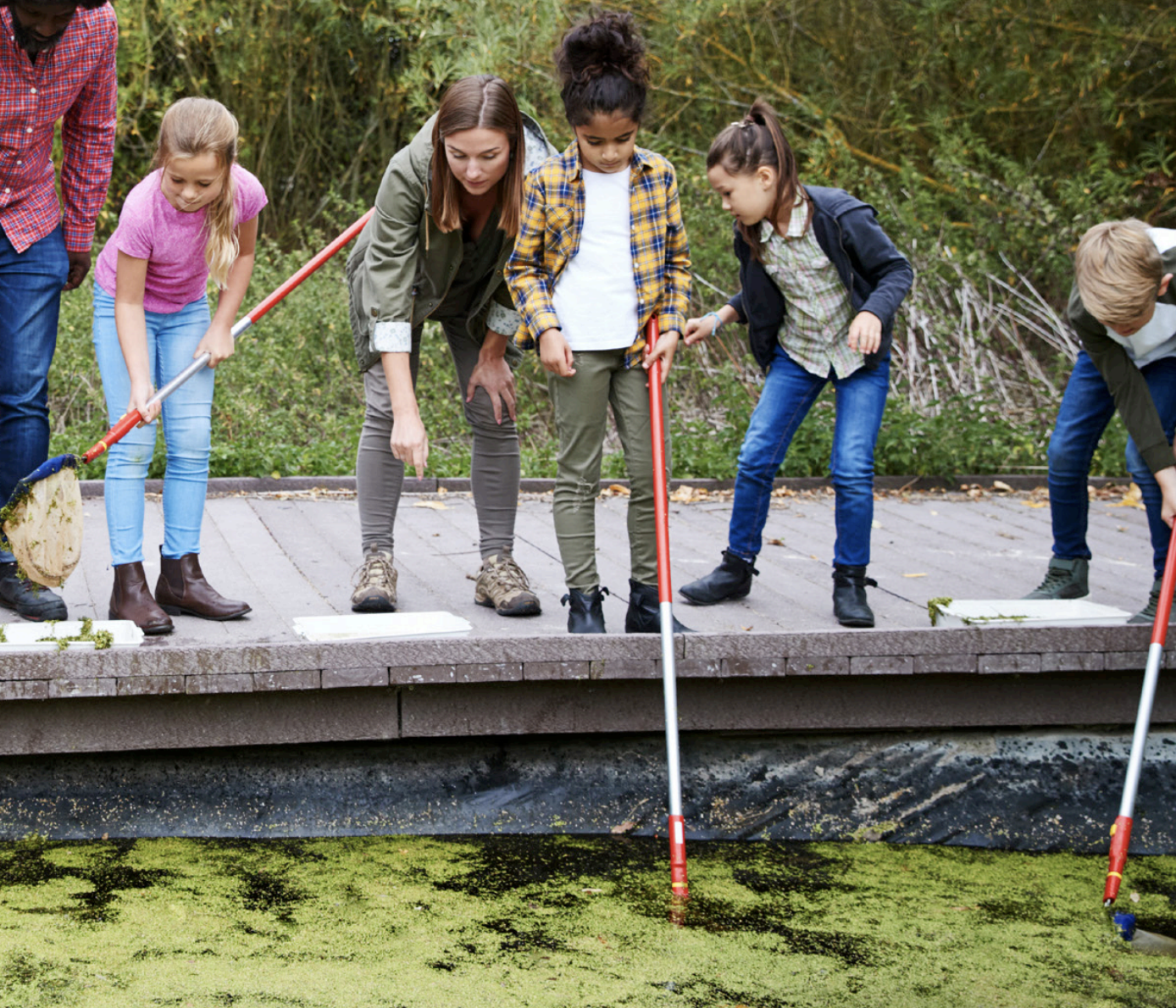Do you want to catch an underwater, jet-propelled bug snatcher? What about a gyrating pond skater? Or how about nature’s scuba diver? You can discover these and more by exploring the amazing critters that live under the surface of the water. All you’ll need is a nearby pond and a few items:
- Fine-meshed net
- Small white container
- Tweezers
- Paintbrush
- Hand lens or magnifying glass
If you can obtain a field guide to aquatic invertebrates (bugs)—you can borrow one from your local library—all the better!
Catch & Release
Ponds
Reach out with your net and scoop up some water and mud near the edge of the pond; then use your hand to push the net upward. Do you notice anything wriggling? Take your tweezers, or if the critter is very tiny, use the paintbrush and gently move it into your container with a bit of fresh pond water.
In the pond, you might find a baby dragonfly. It has a lower jaw that is hinged and can fold outward with claspers on the end. The dragonfly nymph (i.e., baby) can take water in through its mouth and expel it out of its rear end, shooting forward so it can grab onto its prey—catching small underwater insects, even small fish. There you go, an underwater, jet-propelled bug snatcher!
Perhaps you’ll catch a whirligig beetle. These agile critters dart in circles across the surface of the water. They are streamlined with flat bodies and powerful hind legs that can propel them at great speeds. Whirligigs’ eyes are split, so they can see above and below the water simultaneously. Yes, a gyrating pond skater!
Believe it or not, there is a predaceous diving beetle that takes air along with it in a bubble as it plunges under the surface of the water. The bubble provides a handy pocket of air so that the beetle can breathe as it searches for prey—in other words, a bug scuba diver!
Streams
If you’re near a stream, place your net vertically onto the stream bed. Make sure the surface of the net is facing upstream, with the net itself billowing downstream. With your foot, gently move the stones and pebbles directly in front of the net, so whatever is hiding underneath flows into it.
In the stream, you might find mayfly nymphs that undulate up and down like “Aquaman” when they move through the water. Or perhaps you’ll catch the very flat and prehistoric-looking stonefly nymphs that swim by, flicking their abdomens from side to side. These are just some of the fascinating underwater critters you can find in a nearby pond or stream.
Study the critters in your container. How do they swim? What kind of mouth parts do they have? What do you think they eat? Are they camouflaged? How do you think they breathe? If they’re nymphs or larvae, what will they turn into? Use your field guide to help you identify some of the critters you’ve caught. Don’t forget to gently return them to the pond or stream when you’ve finished looking at them.
CALLING ALL WATER STRIDERS
Skating on ice is one thing, but skating on water? How cool would that be! Well, there is an insect that can glide over the surface of ponds, rivers, and lakes during the warm summer months. It’s called a water strider (not a spider, for it only has six legs, not eight). Water striders take advantage of surface tension to “row” across the water, using their paired legs. They also have small hairs that can both repel water and absorb air.
Water striders are predators; when they feel the surface of the water being disturbed, they immediately scoot over to investigate—hoping to find an insect in distress to make a tasty meal. You can attract a water strider by placing two thin twigs in the water. Hold the first halfway under the surface of the water (don’t move this twig). Place the other twig beside the first, but don’t let them touch. Move this twig up and down like a sewing needle. Your movements will create ripples that simulate a struggling insect. Don’t be surprised if a water strider or two glides over and grabs your twig!
Make A Pond Viewer
Seeing underwater is a challenge for us humans because water has the same density as the fluid inside our eyes— meaning that light doesn’t bend as it enters our eyes, and as a consequence, everything seems blurry. But you can make your own viewer that works surprisingly well in shallow water. Here’s how:
You’ll need a large coffee can or an 18-inch (45 cm) section and a piece of Plexiglas. Remove both ends of the can and attach the Plexiglas over one end so that it’s as tight as possible. Secure it with duct tape. Place the Plexiglas end under the surface of the water and look through the other end. Move quietly along. You’ll be amazed at how clear the underwater world becomes with your homemade pond viewer. Try taking pictures or even videos!
This educational article was written by our Executive Director, Jacob Rodenburg. Click the link to download it!

